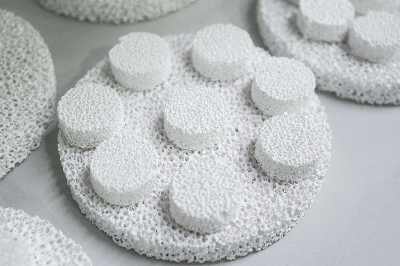What Is a Ceramic Filter?

A ceramic filter is made of ceramic. There are two types of filters: one for purification and the other for noise removal. The former filters impurities from chemical raw materials, while the latter blocks energy of specific frequencies. Ceramic filters are used for both purposes.
Ceramic filters for purification and filtration are primarily used for separating and concentrating raw materials. Ceramic filters for noise rejection are used to reduce noise in audio/visual and communication equipment.
Uses of Ceramic Filters
Compared to LC filters, ceramic filters for noise reduction are compact and lightweight, making them ideal for equipment miniaturization. They are used in various products, including:
- Home audio and portable audio devices
- Televisions/VTRs
- Wireless data communications and smartphones
- Commercial wireless applications
When uploading voice data to the cloud, it can compress the data volume while removing noise. This is a valuable asset in today’s increasingly cloud-based environment.
Ceramic filters for purification and filtration offer excellent heat resistance and a long lifespan. They are used in various applications, such as:
- Pretreatment of wastewater and wastewater treatment equipment
- Lens and glass polishing
- Food purification, turbidity removal, and sanitization
- Concentration recovery and purification of chemicals
- Chemical purification
- Reclamation of waste oil and liquid waste
- Automotive plants (water-soluble coolant regeneration, hydraulic oil, and lubricant regeneration)
An example of food use is in coffee filters. Removing various salty tastes from coffee is recommended to give it a distinct taste.
Features of Ceramic Filters
- Ceramic Filters for Noise Reduction
Ceramic filters for noise rejection have the following features:
- Non-Adjustable: The filter utilizes piezoelectric ceramics to incorporate electrical components within the same element. It is resistant to harmonics and unaffected by peripheral additive circuits. Piezo-ceramic materials include barium titanate porcelain and lead zirconate titanate porcelain.
- Lightweight and Compact: If an IC is used for the amplifier, the gain per stage is larger, allowing for a quicker creation of a concentrated filter compared to an LC filter.
- Centralized Filter: Smaller than LC filters, contributing to space saving.
- Ceramic Filters for Purification and Filtration
Ceramic filters for purification and filtration have the following features:
- Filtration Accuracy: Made of high-purity alumina ceramics, the pore distribution on the membrane surface is uniform, resulting in high filtration accuracy.
- High Corrosion Resistance, Heat Resistance, High Strength, and Wear Resistance: Can be repeatedly cleaned with chemicals. Steam sterilization at about 120°C is also possible. Effective for filtration of high-viscosity liquids and slurries.
- Backwash Reproducibility: Capable of back-pressure washing, ensuring a stable filtration flow rate for an extended period.
- Wide Variety of Pore Sizes: Membranes can be selected to meet specific requirements.
Other Information on Ceramic Filters
- Ceramic Filters for Dust Collection
Bag filter-type dust collection systems have a limit to the heat resistance temperature depending on the type of filter cloth. If the heat resistance temperature is exceeded, there is a high risk of fire because combustion ash is mainly composed of carbon. Changing the filtering material from cloth fiber to ceramic filter allows the heat resistance temperature of the dust collection system to be designed higher, thus increasing the amount of material fed into the combustion furnace.
In addition, if the operation is controlled at or above the acid dew point of sulfuric acid gas, it can prevent corrosion and combustion ash accumulation, and operation time can be extended. Compared to fabric fibers, ceramic filters are filter media that can be recommended for introduction into fabric filters.
- Problems with Ceramic Filters for Dust Collection
Unlike fabric fiber filter cloth, ceramic filters in dust collectors are not flexible. They can be damaged and fall out due to gas flow. They may also break and fall off due to earthquake shaking. Cloth fiber filter cloth can also cause problems due to falling off, but in the case of ceramic filters, the combustion ash discharge hopper can be blocked.
Long ceramic filters are often unsuitable for installation due to frequent dropout problems. Shortening the length reduces dropout but reduces dust collection efficiency. Disposal of used ceramic filters is also difficult. Since they are a mixture of noncombustible ceramic and combustion ash, they must be melted down or land-filled. However, combustion ash may contain mercury, and few companies can accept melting and landfill disposal.